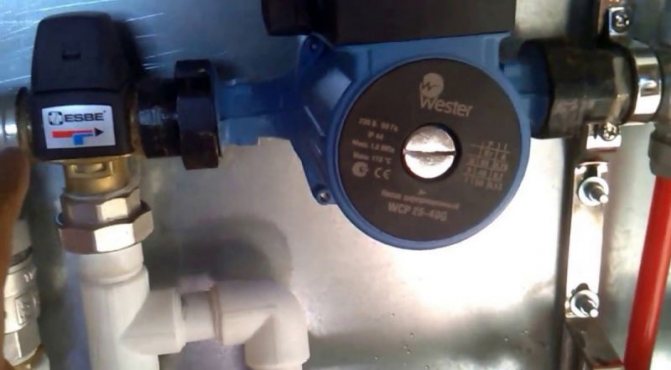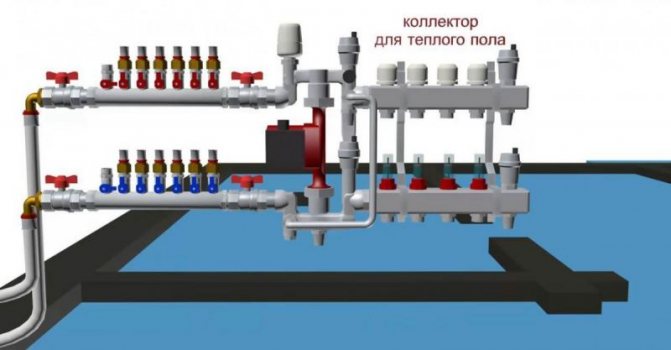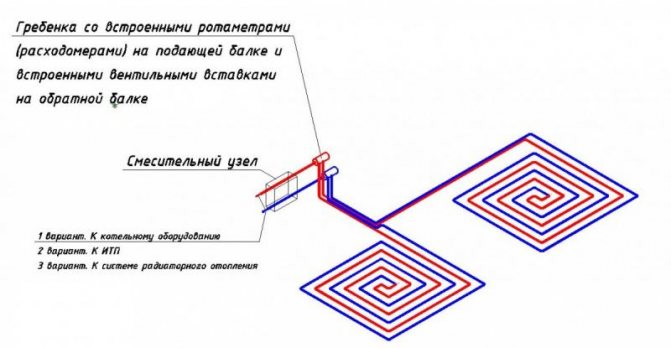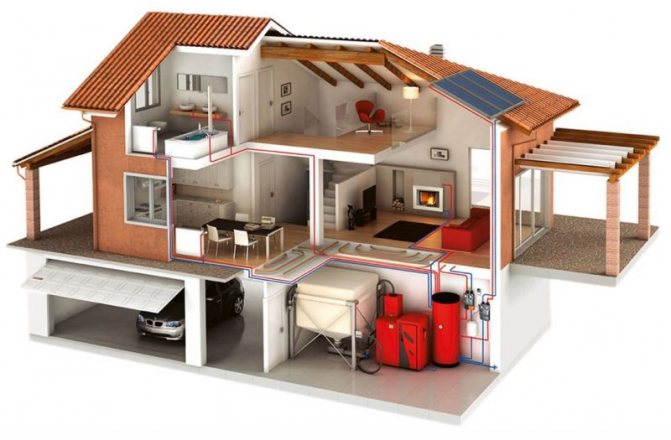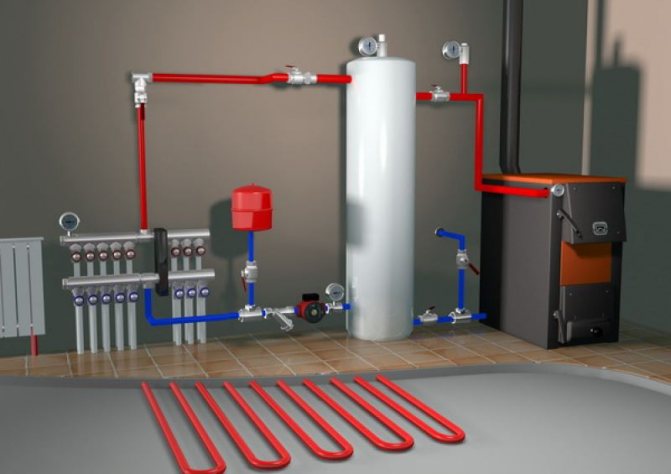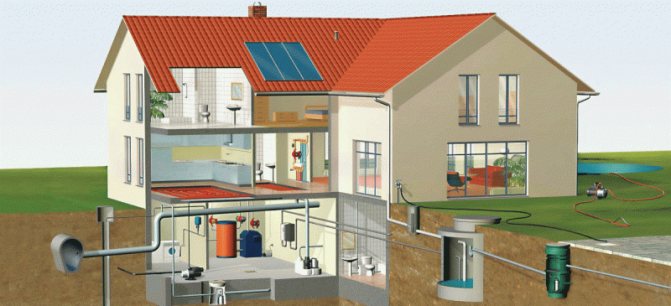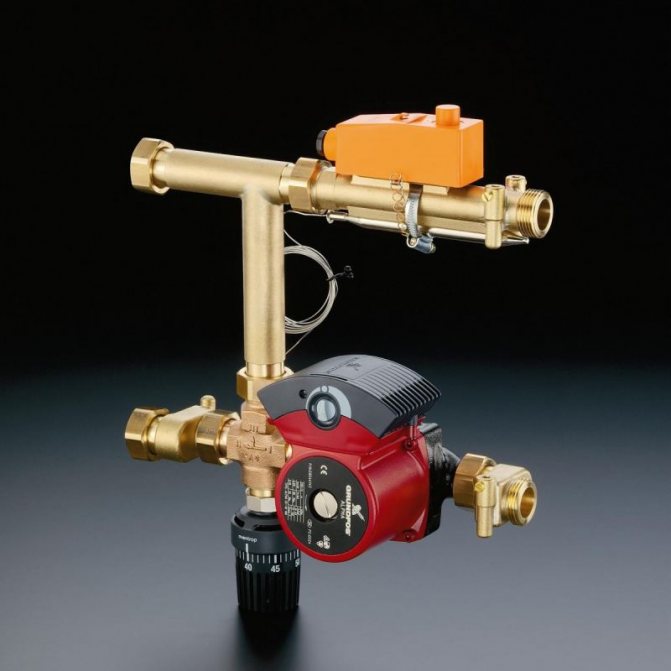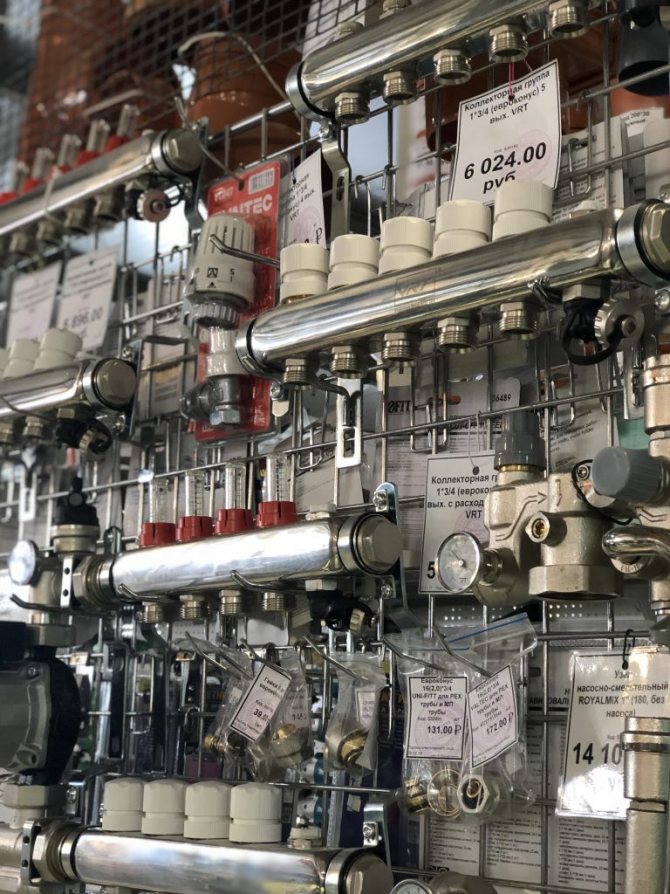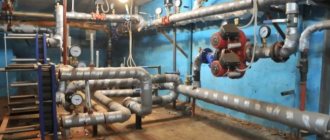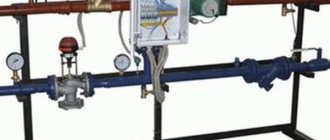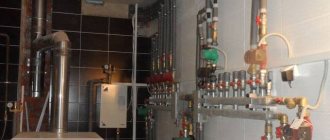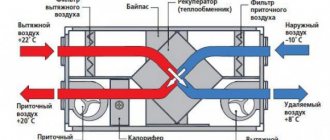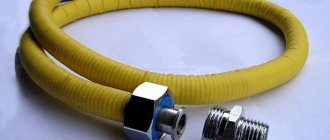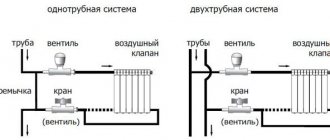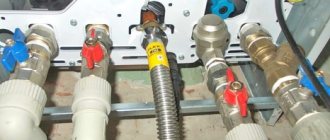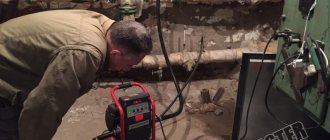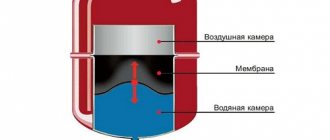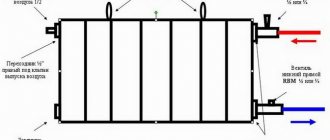Selection and installation of radiators
For the bottom connection, bimetallic heating radiators are recommended, they are easy to assemble, install and repair. The radiator sections can be removed, added or replaced if damaged.
When buying, it is better to give preference to domestic manufacturers, it is important to check the integrity of the battery and packaging. Documentation must be understandable and written in Russian
Before installing, you need to do the markup. it is done with a pencil on the wall. This marks the points where the brackets will be installed. The bottom of the radiator must be at least 7 cm from the floor and 10 cm from the window (if located under the window). The distances are maintained so that the air in the room can circulate freely. The distance to the wall should be about 5 cm.
For more efficient circulation of the coolant, heating radiators are installed with a slight slope. this also eliminates the accumulation of air in the heating system.
When connecting, it is important to follow the markings and not to confuse the return and flow. If connected incorrectly, the radiator may be damaged and its efficiency will decrease by more than 60 percent.
The following types of bottom connection are distinguished:
- one-sided piping - pipes come out from the corner at the bottom and are located side by side, heat loss can be about 20 percent;
- versatile piping - pipes are connected from different sides. such a system has more advantages, since the length of the supply and return lines is less, and circulation can occur from different sides, heat loss is up to 12 percent;
A top-down connection is also used. but in this case it will not be possible to hide all the heating pipes, since the coolant will be supplied in the upper corner, and the output will be from the opposite lower corner. If the heating radiator is short-circuiting, then the return line will be brought out from the same side, but from the lower corner. In this case, heat loss is reduced to 2 percent.
If you plan to connect heating radiators yourself, it is important to follow the installation and safety techniques. During installation or repair, the coolant must be drained, the batteries are cold
If in doubt, it is better to call the wizard or use the training video lesson, since it will be difficult to repair the sections with the lower connection. It is better to plan a heating system with bottom heating together with the layout of the house.
Heating radiators with bottom connection Aluminum radiators for home Steel panel radiators Heating radiators or underfloor heating
Is it worth using a one-pipe heating system
When laying pipes, a 2-pipe heating system is often used. Schematically, it can be represented in the form of 2 circuits, one is responsible for supplying hot water to the radiators, and the second for removing the cooled coolant and supplying it to the boiler. This approach allows you to organize the circulation of water of the same temperature in all batteries.
A significant drawback of this method of organizing heating is considered to be the financial cost of pipes (the price of a device for such heating will be approximately 1.5-2 times more than that of a one-pipe one), and the labor intensity increases. In addition, the pipes will be more difficult to mask.
The single-pipe scheme does not imply the presence of a separate riser for the removal of the cooled heat carrier, that is, about half the pipes will be required.Schematically, it can be represented in the form of a closed loop, and the connection of radiators with a one-pipe heating system is performed sequentially.
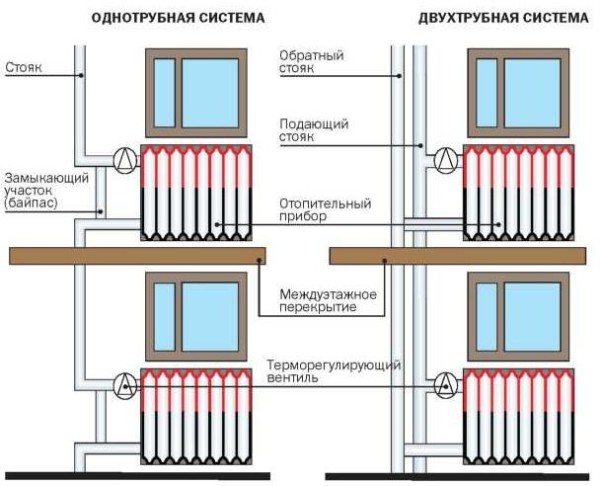
Comparison of one- and two-pipe heating system
Such a system began to be widely used during the construction boom even under the USSR, at the same time its significant shortcomings were discovered:
the main thing can be considered the fact that the last batteries in the circuit receive a coolant with a temperature about 30-50% lower than those nearest to the boiler, this leads to the fact that the rooms are heated extremely unevenly;
Note! This disadvantage can be easily solved by increasing the number of sections of the last radiators. But when building a large number of objects, this will lead to an increase in calculations, which is not very convenient
- you will need a rather powerful pump, it will not work to organize the movement of the coolant by gravity;
- it is characterized by large heat loss;
- system start-up takes longer than in the case of a two-pipe system;
- when doing work with your own hands, the risk of air jams during operation is especially high. It is just that quite often it is not possible to withstand the necessary slopes along the entire length of the pipes.
The listed list of disadvantages is typical for a conventional one-pipe heating system. Nowadays, most of the listed disadvantages are successfully eliminated by installing simple devices. For example, it is already possible to regulate the temperature in individual batteries, and the installation of balancing valves will allow to achieve almost the same operating conditions for all batteries in the circuit.
Given the significant savings on materials, such a heating system scheme definitely deserves attention.
Other accessories for connecting radiators
The design documentation usually contains a list of all components for the heating system. Based on specific data, you may need:
- drain valves - are necessary to remove air locks that may arise during the operation of the heat supply system and affect the overall efficiency of its operation;
- manual control valves - such components for heating radiators to buy it is advisable if you need a simple and quick regulation of the rate of supply of the coolant or its economy when natural opportunities arise for this;
- brackets - special fasteners for fixing many models of radiators to the walls;
- transitions - are needed to connect pipes and radiator outlets for connection at different cross-sections of counterparts;
- corners - are used for convenient piping to heating radiators, without changing the position of the equipment and the pipeline.
Regardless of what kind of components for heating radiators you need, be sure to consider the price of fittings and fittings for heating, the materials at the base of the products (they must be strong, corrosion-resistant), the cross-section of the outlet openings.
One-pipe and two-pipe heating systems
Depending on the number of pipelines, the systems are single-pipe, double-pipe and beam. In a one-pipe system, the coolant is supplied through one pipe, passes through the channels of the battery, gives off some of the heat, and goes back into the same pipe. The only advantage of such a system is the ease of installation and the minimum amount of consumables. Due to these features, such an installation scheme is used in the construction of multi-storey typical houses. The radiators are connected in series, respectively, in devices remote from the boiler, the temperature of the coolant decreases.If the supply and return in the heating system is made by one pipe (lateral connection of the heating radiator from a vertical riser), it is impossible to regulate the temperature of a separate device, since a narrowing or blocking of the flow will affect the operation of all subsequent batteries. To provide this possibility, a jumper must be installed between the supply and return pipes.
In two-pipe systems, two pipes, supply and return, are separately supplied to each battery. At the same time, the pipe consumption increases, but the system works much more efficiently. It is recommended to connect the radiator to a two-pipe heating system diagonally, but other connection methods can be used depending on the location of the pipelines. The two-pipe system has several advantages:
- Natural and forced circulation of the coolant can be used.
- A heating connection diagram of any complexity can be used, taking into account the architectural features of the building.
- The temperature control of each device is carried out separately and does not affect the operation of the system as a whole, which allows you to maintain different temperatures in individual rooms.
Collector wiring (beam system) involves the supply of coolant to each battery (or room) directly from the boiler. The temperature control of the devices is carried out using the manifold control valves. This wiring method allows you to connect a heated towel rail or underfloor heating system to the heating system, regardless of the batteries.
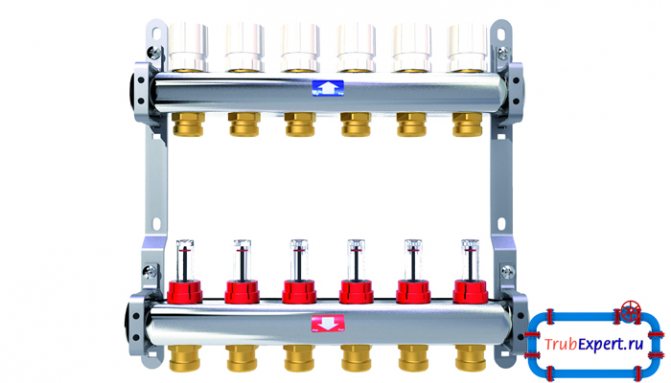

Manifold for distributing pipes of the heating system
The collector wiring allows you to balance and adjust the system with a high degree of accuracy, however, in addition to its advantages, it also has many disadvantages:
- High cost. The pipe consumption increases several times and the installation of additional equipment (manifold, hydraulic separator) is required.
- The pipe is laid into the screed in one piece; joints in the screed are not allowed.
- Natural circulation is not enough; installation of a circulation pump is required for each circuit. The use of electrical equipment makes the system dependent on power supply.
- Limitations when choosing the type of pipe. Usually, a reinforced plastic pipe or XLPE is used. Connecting the radiator to polypropylene pipes, which are at an affordable price, is impossible in this case.
What are the types of connection nodes
These connecting elements differ depending on the heating system layouts:
- one-pipe;
- two-pipe;
- combined.
With a one-pipe version, the heating devices are connected in series. A big minus - the temperature of the coolant decreases with distance from the heat source. Therefore, the last batteries are usually lukewarm. Equalize the situation with a built-in bypass. Half of the liquid in the water circuit passes through it.
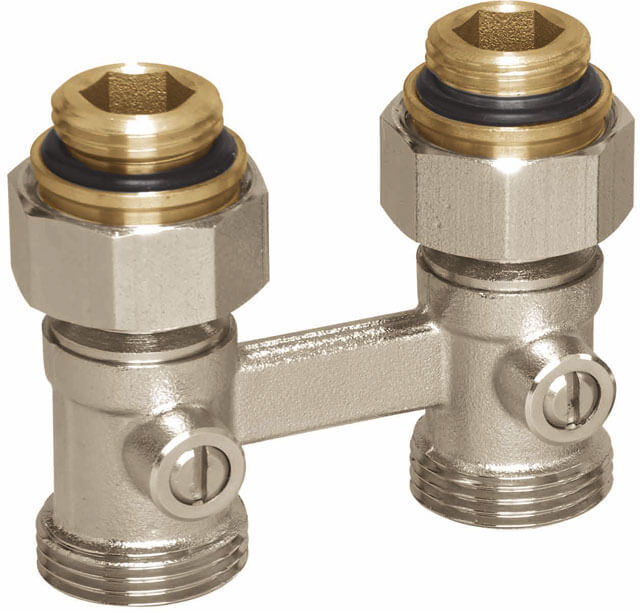

The two-pipe version provides for a parallel connection. This means that the heat will be evenly distributed throughout the system, such a module is simpler and more reliable. No additional movements associated with temperature compensation are required.
They install the nodes of the lower connection of the radiators for two-pipe systems and for one-pipe systems. By rotating the shutter specially built into the bypass structure, the fluid flow in the water circuit, which goes past the radiator, is regulated. Thus, the operating mode is switched.
The device is also distinguished by another method of connecting the radiator: direct or angular. Direct mechanisms are designed to connect radiators to horizontal heating circuits that are laid under the floor (technical underground). Corner devices are used in a wall niche. Some designs provide space for a thermal head and valve.
Rifar aluminum radiators with bottom connection
Rifar Alum 350 Ventil 1400 rub.
Today, when designing a heating system in a country house, much attention is paid to the rationality and compactness of systems. Therefore, the bottom connection of radiators is the most versatile and aesthetic option, due to the fact that all return and supply pipelines are carried out under the floor, and the connection to the radiator is carried out at the bottom, which is very convenient
It was believed that the bottom connection allows you to reduce the efficiency of heating systems by 5%, but today, thanks to modern developments, this opinion has changed. For such heating devices, underground piping is optimal. In such devices, for better distribution of the coolant, distribution pipes are used.
The best choice is the Rifair radiator, which, in the case of bottom connection, is completed with a special thermostatic device located in the body of the heater. Rifair radiators use a seamless technology without the use of welding, which allows the use of oil as a heat carrier, as well as various antifreeze anti-freeze liquids. Thanks to a special lightweight aluminum alloy, a high heat transfer rate is provided, and the special design of the internal channels and the body allows it to withstand high pressure.
In terms of overall dimensions and the best heat transfer indicators, domestic radiators with a bottom connection Rifar stand out, where, having a special compactness, they can heat fairly decent areas of premises. All models are capable of withstanding pressures up to 20 bar and coolant temperatures up to 110 C.
In private houses and multi-storey buildings, it is recommended to use Rifar steel panel radiators, consisting of several panels. A distinctive feature is a two-layer environmentally friendly varnish coating that does not emit harmful substances into the environment, and special methods of performing the painting process and applying protective layers reliably protect the heating device. In the case of a bottom connection, a ¾ ”male thread is provided. Among the options offered, there is a large selection of sizes, where you can choose the right model for any ceilings and window sill.
Universal Russian radiators Rifar with bottom connection can be installed in heating systems with copper, steel, metal-plastic and polypropylene pipes. All models are injection molded.
We are doing our best.
All Rifar heating radiators are technologically advanced radiators made under the strict supervision of professionals.
Multiflex straight-through, white more →
To connect radiators with bottom connection to the heating system, a Multiflex shut-off and connection unit is usually used. The unit contains ball elements to completely disconnect the radiator from the heating system. Regulation of the coolant flow in this unit is not provided - the power of the radiator is usually changed with the help of a thermo-valve built into it.
Price: 2 066 rub. Buy Details
This node is suitable for connecting the following models:
- Radiator Arbonia 3057 No. 69 tvv
- Radiator Arbonia 2057 No. 69 tvv
- Radiator Arbonia 3030 No. 69 tvv
- Radiator Arbonia 3180 No. 69 tvv
- Radiator Arbonia 2180 No. 69 tvv
And also for all models with a letter in the designation V or connection numbers No. 69, No. 89, No. 98
Strapping made of polypropylene pipes
Before connecting aluminum radiators with polypropylene pipes, you should draw up a piping diagram
When compiling it, it is important to avoid unnecessary knots and "bends" in the pipes, which will make the work more reliable
The piping can be carried out both in one-pipe and two-pipe heating systems, but taking into account the following nuances:
- In the first option, the installation of a bypass is required.
- With a two-pipe system, additional connecting elements are required.
Polypropylene pipes can be connected in two ways:
- The most reliable is soldering. since the ends of the pipes and the tee are fastened together so firmly that they become a single system that is not afraid of either high temperatures or an increase in pressure. Soldering is performed with a special tool.
- If using fittings. for fixing which special devices are not needed, then you should be prepared that they will have to be tightened up and checked regularly. This is due to the fact that when heated, the pipes expand, gradually weakening their "grip". As soon as the fasteners are loose, a leak will follow.
In order for everything to be done correctly, you must follow the sequence of actions:
- Check that the cuts of the part of the harness that goes directly to the battery are even. Cut the pipe again if necessary.
- The next step is to solder the trim parts that fit the fitting located at the top of the radiator. Even a beginner can carry out this procedure with a special soldering iron. It is enough to insert one part of the tee into the pipe, warm up the joint with a soldering iron and hold them until the seam cools down. This usually takes no more than 3 minutes. The same process is carried out with the other side of the tee.
- Assembling the lower part of the harness. which is connected to the lower fitting, is carried out in a similar way, only more adapters are required.
- The locking device is connected to both parts of the trim. for which the branch pipe is unscrewed.
After the shut-off valves are connected, all the nuts are tightened, having previously screwed tow soaked in sealant onto the thread of the fitting.
If you decide to install aluminum radiators, it is important to know the following:
As practice shows, the alteration of aluminum radiators for the bottom connection is in great demand, especially in houses with autonomous heating. They look more aesthetically pleasing, evenly and quickly heat up the room, but they require some knowledge during installation, so it is recommended to trust their installation to professionals.
Thermoregulation
Ball valves
- Ball valves BUGATTI (Italy)
- Ball valves BUGATTI (Series 900)
- Ball valves (mini series 800) BUGATTI
- BUGATTI taps for connection (washing machines, mixers)
- Ball valves FIV Evolution (Italy)
- Check valves, filters, gate valves Bugatti (Italy)
MVI products
- Ball valves PREMIUM series
- Ball valves H2O series
- Ball valves AquaHit
Galvanized pipes
- Galvanized pipe in SANHA rods
Copper pipes
- Copper pipe in coils KME (Germany)
- Copper pipe in rods KME
- Copper air-conditioning pipe KME
Fittings for galvanized pipes
- Press fittings SANHA (Germany)
Copper pipe fittings
- Brazing fittings - SANHA brazing (Germany)
- Soldering fittings - SANHA thread (Germany)
- Fittings brazed-brazed VIEGA (Germany)
- Brazing fittings - VIEGA thread (Germany)
- Solder, ruffs, clamps, consumables
- Crimp fittings (Italy)
Radiators GLOBAL
- Bimetal GLOBAL Style Plus
- Bimetal GLOBAL Style
- Aluminum GLOBAL VOX
- Aluminum GLOBAL Klass
- Aluminum GLOBAL Ekos
- GLOBAL accessories
Installation systems VIEGA
- Toilet installation Viega Standard
- Installation for wall-hung toilet Viega Eco
Metal-plastic pipe
- SANHA metal-plastic pipe (Germany)
- Metal-plastic pipe COMAP (France)
- Metal-plastic pipe FIV (Italy)
Fittings for metal-plastic pipes
- Fittings - press COMAP (France)
- Fittings - press FIV (Italy)
Polypropylene pipes and fittings
- HEISSKRAFT pipe
- HEISSKRAFT polypropylene fittings
Threaded Brass Fittings
- SANHA Threaded Fittings
Sewer pipes and fittings
- Sewer pipe OSTENDORF
- Sewer fittings OSTENDORF
- Outdoor sewerage
- Outdoor sewerage fittings
Pump equipment
- Circulation pumps GRUNFOS
- Circulation pumps HALM
- Pumps pumps BIRAL
Collectors and cabinets
- COMAP collector
- Bracket for manifolds
- Outside switchgear cabinet
- Built-in distribution cabinet
Thermoregulation
- Thermostats for thermostatic valves M28 - M30
- Decorative thermostats М28 - М30
- Thermostatic valves for radiators M28 - M30
- Decorative thermostatic valves M28 - M30
- Thermostatic return valves
- Manual valve
- Decorative valves for manual adjustment FUTURA
- Decorative valves for manual adjustment SPHERE
- Thermostats
- Radiator connections
- Distribution nodes
- Valves for one-pipe, two-pipe distribution
- Fitting
- Setting tool
Insulation for pipes, clamps
- Pipe clamps with sound insulation, nut М8
- Insulation TERMAFLEX
Balancing valves
- Balancing valves COMAR
- Ballorex balancing valves
Safety fittings
- COMAP security group
- Safety valves COMAP
- Pressure reducer COMAP
MEIBES products
- Pumping groups
- Collectors
FLAMCO products
- Flamco Clean (Dirt)
- Flamcovent (Air)
- Flamcovent Clean (Air / Dirt)
- Flexcon C tanks
- Wall-Mount Flexconsole
Sale
- Fittings - Crimp COMAP (France)
- Metal-plastic pipe FIV (Italy)
- Pipe Majdanpek (Serbia) in rods
Choosing a place and method for installing a radiator
The options for connecting heating radiators depend on the general heating scheme in the house, the design features of the heating devices and the method of pipe laying. The following methods of connecting heating radiators are common:
- Lateral (one-sided). The supply and return pipes are connected on the same side, with the supply located at the top. The standard method for multi-storey buildings, when the supply is carried out from the riser pipe. In terms of efficiency, this method is not inferior to the diagonal one.
- Lower. In this way, bimetallic radiators with a bottom connection or a steel radiator with a bottom connection are connected. The supply and return pipes are supplied from the bottom in the left or right side of the device and are connected through the lower connection of the radiator with union nuts and shut-off valves. The union nut is screwed onto the lower radiator pipe. The advantage of this method is the location of the main pipes hidden in the floor, and heating radiators with a lower connection harmoniously fit into the interior and can be installed in narrow niches.
The advantage of most steel radiators with bottom connection is the already built-in thermostatic valve for installing the thermostatic head, so you should not be surprised that they cost a little more than radiators of the same size with side connections.
- Diagonal. The coolant enters through the upper inlet, and the return flow is connected from the opposite side to the lower outlet. The optimal type of connection, which ensures uniform heating of the entire battery area. In this way, correctly connect the heating battery, the length of which is more than 1 meter. In this case, heat loss does not exceed 2%.
- Saddle. The supply and return are connected to the bottom holes located on opposite sides. It is mainly used in one-pipe systems when no other method is possible. Heat loss due to poor circulation of the coolant in the upper part of the device reaches 15%.
When choosing a place for installation, several factors are taken into account that ensure the correct operation of heating devices. Installation is carried out in places least protected from cold air penetration, under window openings. It is recommended to install a battery under each window. The minimum distance from the wall is 3-5 cm, from the floor and windowsill - 10-15 cm. With smaller gaps, convection worsens and the power of the battery decreases.
Typical mistakes when choosing an installation site:
- The place for the installation of the control valves has not been taken into account.
- The small distance to the floor and window sill prevents full air circulation, as a result of which heat transfer decreases and the room does not warm up to the set temperature.
- Instead of several batteries located under each window and creating a heat curtain, one long radiator is chosen.
- Installation of decorative grilles, panels that prevent the normal spread of heat.
Coolant circulation methods
The circulation of the coolant through the pipelines occurs in a natural or forced way. The natural (gravity) method does not involve the use of additional equipment. The heat carrier moves due to a change in the characteristics of the liquid as a result of heating. The hot coolant entering the battery, cooling down, acquires a greater density and mass, after which it goes down, and a hotter coolant enters its place. Cold water from the return flows by gravity into the boiler and displaces the already heated liquid. For normal operation, the pipeline is installed at a slope of at least 0.5 cm per meter.
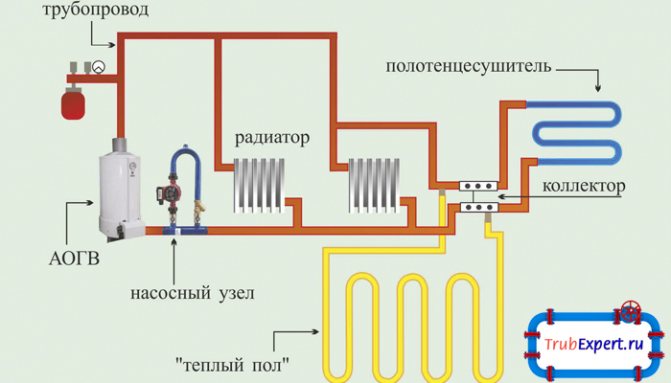

Circulation diagram of the coolant in the system using pumping equipment
For the forced supply of the coolant, the installation of one or more circulation pumps is required. The pump is installed on the return pipe in front of the boiler. The operation of heating in this case depends on the electric power supply, but it has significant advantages:
- Small diameter pipes are allowed.
- The line is installed in any position, vertically or horizontally.
- A smaller volume of heating medium is required.
Installation of radiators with bottom connection
The panel heater is connected by a simple tool in the form of a wrench, if adjustment is made, a hexagon or flat screwdriver is used. Since all branch pipes are equipped with hermetic fluoroplastic or rubber seals, the use of threads, tow and other waterproofing materials is not required. When connected from below to a common XLPE pipeline, proceed as follows:
- The Eurocone coupling with a union nut is put on the end pipe outlets; its difference from standard compression fittings is that the polyethylene sheath is pressed to the inner fitting through the outer ring with a slot, and the connection to the “binoculars” branch pipe is made with one union nut. The cone at the end of the connector with a rubber gasket fits tightly and tightly into the mating bore when the nut is tightened.
- Fasten the N-shaped unit with an American nut using a key to the radiator from the bottom using ordinary and conical gaskets included in the installation kit of the thermostatic fitting, install the radiator on the floor or hang it on the wall at the desired height.
- Connect the union nuts of the Eurocone coupling with a wrench from the pipe ends to the inlet nozzles of the bottom connection armature.
When carrying out work, the main thing is not to pinch the connections with a wrench, which can cause irreversible rupture of the gaskets and loss of tightness, it is better to tighten all the nuts by hand with maximum effort, and after supplying water in places of leaks, slightly tighten it with an adjustable wrench.
Fig. 10 Example of mounting a radiator on bottom fittings (Hummel)
The main advantages of the lower radiator connections are aesthetic appearance and economy of materials, while the upper corners of the batteries do not warm up well, as a result of which the heating efficiency decreases by 15 - 20%. The way out is to build in an external bypass, through which the coolant is immediately supplied to the upper radiator pipe.
Although the heat is distributed evenly, this detail reduces the aesthetics of the look and loses one of the main advantages of the bottom liner. The use of built-in bypasses, thermostats, control and shut-off valves in the supply fittings makes it possible to effectively use the bottom inlet device in one-pipe and two-pipe heating systems.
I will certainly think about the last option properly! But if you do, then only at pressfights.I just looked in the net for prices for such fittings - tees in the region of 180-200 rubles per piece. So, if you estimate - this is at least a set for one radiator (two corner taps and two tees) - around 700 rubleffff turns out. And with such a proposed scheme, that's what it turns out to be. Even! The node replaces not two taps on the battery, but three (also on the bypass). Moreover, the bypass line is automatically regulated by a spring, i.e. the more the passage to the battery is open, the less the bypass opens and vice versa. I agree that, on the one hand, such a node is not quite the usual implementation and with small flow areas and therefore a limitation of power on one branch. But here no one is talking about the endless growth of the branch. In the diagram, two large rooms, as a last resort, can be divided into two branches, that is, put another tee in the center and run a thickened pipe. On the other hand, only two connections are required to install the node! Do not think, I have nothing to do with the production and trade of these nodes. I just want to work out for myself the best option for the price of equipment, time and cost of work, as well as the reliability and quality of the system. Of course, I will count all the possible options, but for some reason I somehow lean towards the nodes. Can any of you give specific examples of "non-working" systems using nodes?
forgot to indicate in the figure that the boiler is on the basement floor
but at the expense of a “purely” collector system - I agree that such a system is the best in terms of and the possibility of adjustment and uniformity of work, but it’s not a reason to increase the flow rate of the pipe several times, and even with my layout it is very, very inconvenient to do this.
The main advantages of the lower eyeliner
As noted earlier, this method provides for the supply of hot liquid to the radiator on one side, and the output of the cooled one on the other. Thanks to this, the pipes can be easily hidden, practically without losing their effectiveness. And the batteries themselves warm up faster from below than from above due to the high speed of water circulation.
Sometimes the efficiency of the operated equipment decreases due to the airing of the line or its clogging. But even after that, this method of piping ensures uniform heating of the devices (the efficiency is not lower than in the case of the upper piping).
Important! Regardless of which connection method was chosen, a number of special requirements should be adhered to during installation. And this applies primarily to the ratio between the width of the radiator and a similar indicator of the window
Advantages and disadvantages
The advantages of the lower connection of a bimetallic radiator include:
- Aesthetic look.
With this connection scheme, the pipes are easier to hide. For example, this can be done by hiding them under the floor, in the wall, or under the baseboard. - Ease of installation.
The pipes are connected directly, with this option, there are few bends, turns, etc. Thus, the coolant flows without significant obstacles. - The price of the lower connection scheme is less than the rest;
- The lower connection system is more stable, that is, it is difficult to unbalance it.
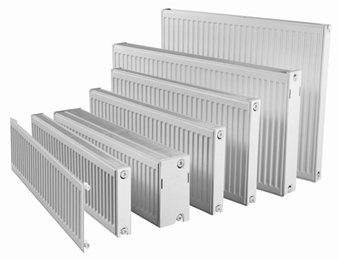

Fig. 3 Panel models of bimetallic radiators
Disadvantages of bottom connection:
- If the pipes are run under the floor to achieve an aesthetic appearance, it will be very difficult to repair the leak. It will be necessary to dismantle the floor. In an apartment building, such a system is not connected, since there is a central heating system.
- The level of heat transfer from radiators with the lower supply circuit is slightly less than with other connections.
As for the small heat transfer, this can be explained by the design of the channels in bimetallic radiators. The hot coolant is fed into the battery and heats up its bottom very quickly. The top of the battery is heated by convection.Thus, the top of the battery may not be completely heated, and air will constantly collect there.
This also applies to the situation when the coolant consists of water and antifreeze (Fig. 4). Antifreeze is heavier than water and is always at the bottom, and the water will rise up. Thus, with the lower connection scheme, the circulation of the coolant inside the device is disturbed. This results in little heat dissipation and inefficiency of the lower wiring diagram.
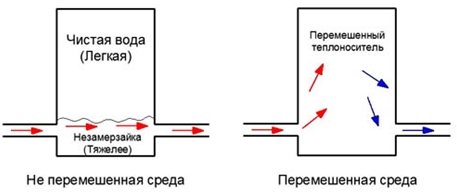

Fig. 4 Circulation of coolant with antifreeze
How to properly connect a bimetallic radiator? Of course, for this you need to have certain knowledge and skills. Correct connection of a bimetallic heating device consists in observing some rules. It should be noted that it is better to connect the lower pipe scheme at the beginning of the repair work. Since this eyeliner is actually performed because of the aesthetic appearance, the pipes go either under the floor or in the wall.
All distances should be strictly observed, for example, from the floor to the radiator, the correct distance should be at least 15 cm, between the wall and the device at least 2 cm.
Next, using a level, you need to accurately outline the places for the brackets. It is better to install the radiator on a stand and put a level on top, then you can be sure that all measurements are correct. Brackets, as a rule, come with a bimetallic heating device. The number of these mountings must be appropriate for the size of the appliance.
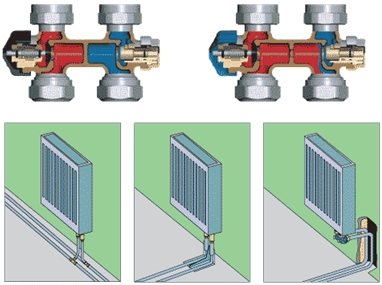

Fig. 5 Correct ways of connecting pipes to a bimetallic radiator
In order to properly connect the pipes, it is important not to confuse the supply and return lines. To prevent this from happening, you need to carefully study all the inscriptions, since there is a corresponding marking on the radiator
If a bimetallic heating radiator is incorrectly connected, heat transfer decreases several times, namely by 60%. Of course, the model of the heating device also depends on this.
The lower tubes, which are L-shaped, should be strengthened, but only after checking the entire system. This is done, as a rule, with the help of polyurethane foam.
Installation and connection of bimetallic radiators must be carried out in protective packaging
This is very important, because if the paint on the radiator is damaged, an irreversible process can take place. The paint will continue to swell from damage
If this happens, but you need to purchase a special enamel-based paint and process the scratch. The packaging must be on the radiator before connecting.
All accessories, plugs and taps must be complete with a radiator, but this must be checked with a consultant in the store. Namely, this is Mayevsky's crane and plugs for another manifold. Correctly install the Mayevsky crane with a torque wrench, so as not to overtighten the connection and damage the crane. The connections should never be cleaned with anything, as a leak may appear when the system is started.
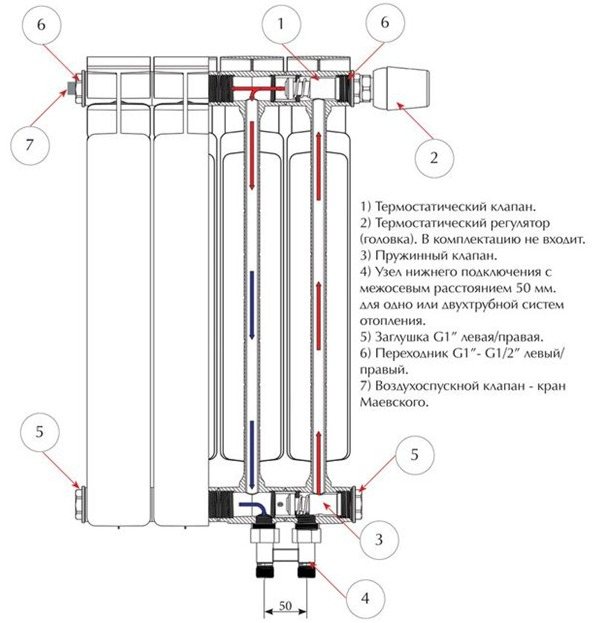

Fig. 6 Device of a bimetallic device with bottom connection
What is a radiator connection assembly
A radiator connection node with a lower connection is an H-shaped piece of sanitary fittings with two parallel fittings at a distance of the seats of a steel panel radiator, and a rigid jumper between them. A typical part has on one side a fitting into a pressed-in union nut with a gasket (American connector) with an internal diameter of 3/4 ", on the other side a 3/4" external thread is applied to the fitting.
A shut-off ball valve or screw valve is located inside each of the inputs, which allows you to regulate or shut off the incoming heat carrier; when removing the battery during its repair or replacement, a shut-off function is used.
Bottom Radiator Connection - Benefits of Use
The radiator fittings, with which the bottom connection is made, are intended for use in steel panel heat exchangers and are not suitable for aluminum radiator sections - this makes the steel types highly competitive. Bottom inclusion in comparison with other types has the following advantages of using fittings:
- Saving pipe materials and bends - in the floor structure or on the wall for connecting the radiator, there are only two short leads, the pipes do not go to its upper inlet.
- The connection at the bottom is aesthetically pleasing, and if the piping comes out of the wall, it is practically invisible under the body and does not interfere with cleaning the floor covering.
- Shut-off and control valves (ball valves or valves) in the "binoculars" allow you to control the intensity of the fluid entering the heat exchanger, and when it is completely closed, remove the batteries for maintenance or repair.
- The bottom connection unit with a vertical bypass evenly distributes water over the radiator with heating of its coldest upper corners, which is observed with the bottom connection. Also, with a single-pipe wiring, the bypass helps to equalize the temperatures of the incoming and outgoing flows, which in turn leads to uniform heating of the devices built into the line.
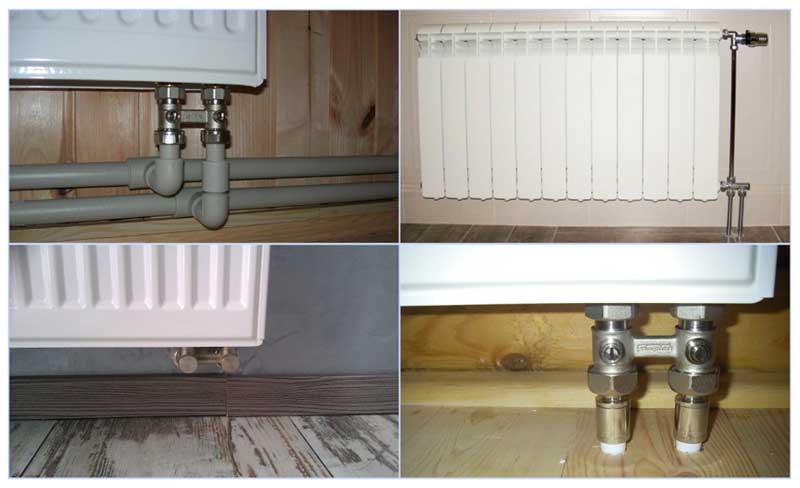

Fig. 2 Straight and Elbow 3/4 '' Bottom Fittings Installed
Radiator connection diagrams
How well the radiators will heat up depends on how the coolant is supplied to them. There are more and less effective options.
Bottom connection radiators
All heating radiators have two types of connection - side and bottom. There can be no discrepancies with the bottom connection. There are only two pipes - inlet and outlet. Accordingly, on the one hand, the coolant is supplied to the radiator, and on the other, it is discharged.
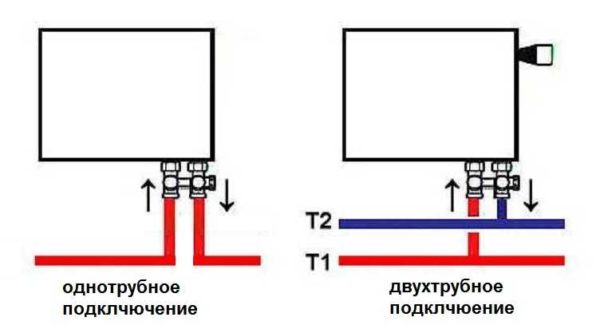

Bottom connection of heating radiators with one-pipe and two-pipe heating system
Specifically, where to connect the supply, and where the reverse is written in the installation instructions, which must be available.
Radiators with side connection
With lateral connection, there are much more options: here the supply and return pipelines can be connected into two nozzles, respectively, there are four options.
Option number 1. Diagonal connection
Such a connection of heating radiators is considered the most effective, it is taken as a standard and this is how manufacturers test their heating devices and the data in the passport for thermal power - for such a connection. All other types of connection give off heat less efficiently.


Diagonal connection diagram of heating radiators with two-pipe and one-pipe systems
This is because when the batteries are diagonally connected, the hot coolant is supplied to the upper inlet from one side, passes through the entire radiator and exits from the opposite, lower side.
Option number 2. Unilateral
As the name implies, pipelines are connected on one side - supply from above, return - from below. This option is convenient when the riser runs to the side of the heater, which is often the case in apartments, because this type of connection usually prevails. When the coolant is supplied from below, such a scheme is rarely used - it is not very convenient to place pipes.
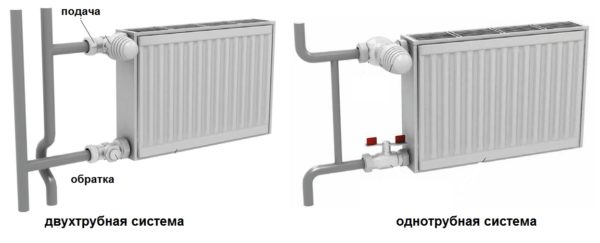

Side connection for two-pipe and one-pipe systems
With such a connection of radiators, the heating efficiency is only slightly lower - by 2%. But this is only if there are few sections in the radiators - no more than 10. With a longer battery, its farthest from the edge will not heat well or even remain cold. In panel radiators, to solve the problem, flow extenders are installed - tubes that bring the coolant a little further than the middle. The same devices can be installed in aluminum or bimetallic radiators, while improving heat transfer.
Option number 3. Bottom or saddle connection
Of all the options, the saddle connection of heating radiators is the least efficient. The losses are approximately 12-14%. But this option is the most inconspicuous - pipes are usually laid on the floor or under it, and this method is the most optimal from the point of view of aesthetics. And so that losses do not affect the temperature in the room, you can take a radiator a little more powerful than required.
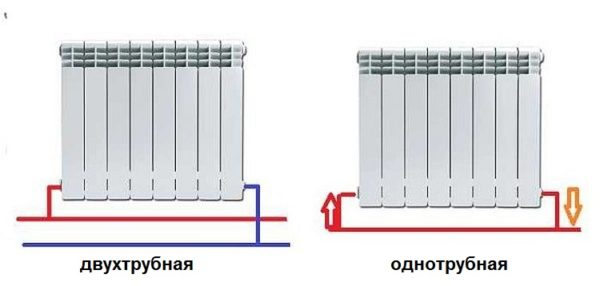

Saddle connection of heating radiators
In systems with natural circulation, this type of connection should not be done, but if there is a pump, it works well. In some cases, it is not even worse than the lateral one. It's just that at a certain speed of movement of the coolant, vortex flows arise, the entire surface heats up, and heat transfer increases. These phenomena have not yet been fully studied, therefore it is still impossible to predict the behavior of the coolant.
Features of the use of nodes of the bottom connection
Connecting to heating systems at the bottom is effective if the supply pipes pass under the floor, sometimes for convenience and aesthetics they are brought into the walls at a low height - corner fittings allow you to connect the pipes to the radiator body.
In addition to shut-off and control valves, to increase the efficiency of work, internal and external bypasses are often built into the valve connecting nodes; thermostats are used to set the temperature regime.
The main material for the manufacture of devices is brass, when purchasing, you should pay attention to the wall thickness and thread length - manufacturers who produce low-cost products make them thin-walled with a short thread.
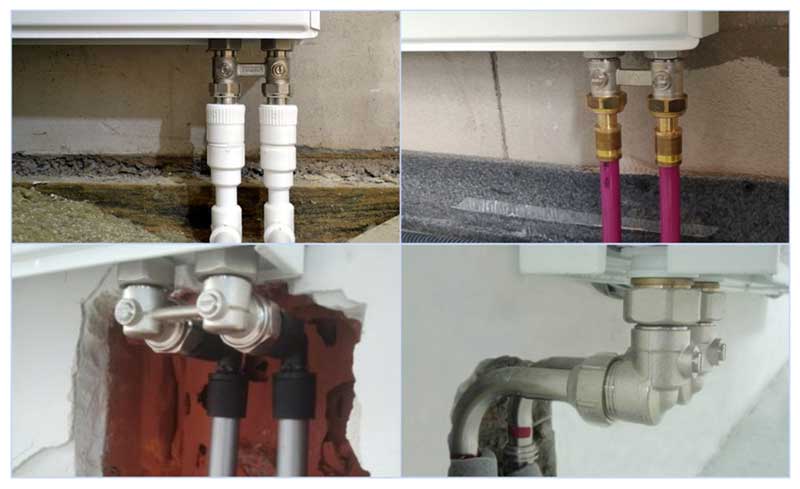

Fig. 3 Bottom connection - installation examples
Bottom connection node types
In individual residential buildings, one-pipe and two-pipe heating systems are used; to connect a stand-alone heat exchanger, a combined method is used, in which, in a wiring with two pipes, it is included only in the supply line according to the Leningrad scheme.
Accordingly, the units with bottom connection produced by the manufacturer are intended for use of valves in one-pipe, two-pipe or combined circuits, their features:
- In a single-pipe line, when the heat-transfer fluid moves sequentially through all heating devices, its temperature drops, which accordingly leads to strong heating of the first batteries in the chain and the cold surface of the latter. To equalize the temperatures of the coolant at the inlet of all devices, thermal compensation is used, which is carried out by bypass wiring, dividing the incoming flow into two branches - one part goes to the radiator and heats its body, the other follows freely to the next battery, mixing with the cooled flow leaving the first heat exchanger.
- In two-pipe systems, the heating temperature of all heaters is uniform and temperature compensation is not required. With this wiring, the basic design of "binoculars" is used - a fitting with shut-off or control valves, one pipe of which is connected to the supply line, the other is connected to the return.
- A combined unit with an internal bypass channel is built into both a one-pipe and two-pipe heating system, in the first case the bypass channel is slightly opened, in the second it is completely closed.
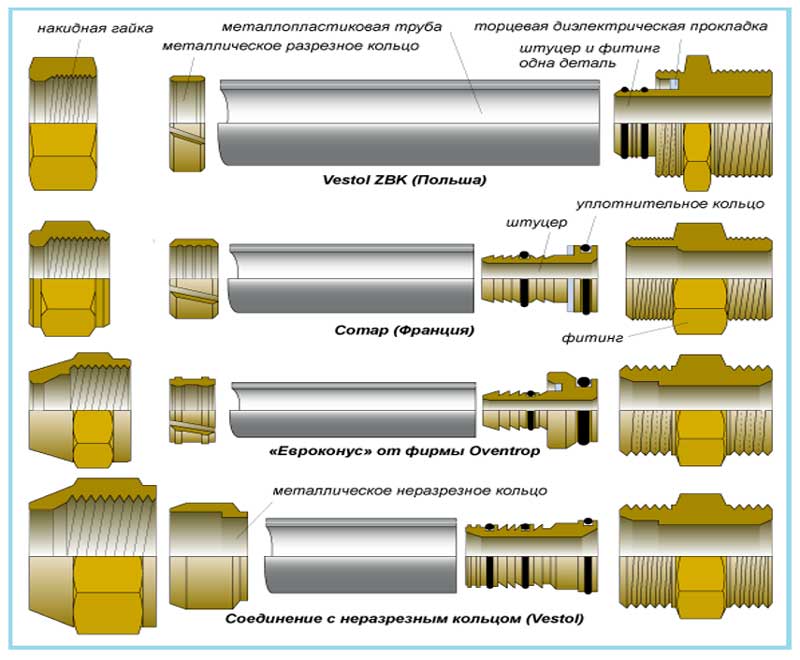

Fig. 4 Fittings from leading foreign manufacturers
According to the design of the housing, there are two main types of bottom connection fittings:
- Straight. Designed to connect radiator modules to pipes vertically extending from the floor, since the outlet branch pipe of the unit has an external thread, the pipes must have outlet fittings with a union nut (American) or a compression sleeve with a transition to American.
- Corner.Corner fixing systems are the best option from an aesthetic point of view, in this case the pipes come out of the wall at a low height from the floor, and the threaded nipples of the angle fitting are connected to them using a union nut installed at the pipe ends.
To connect the node with a line of steel pipes, an American is used; for cross-linked polyethylene (metal-plastic), a special Eurocone compression connector is used. Its fitting is inserted into the pipe and pressed against it by an outer ring with a slot by means of a union nut rotating around its axis, which, together with a conical seal, connects the abutting parts to each other.
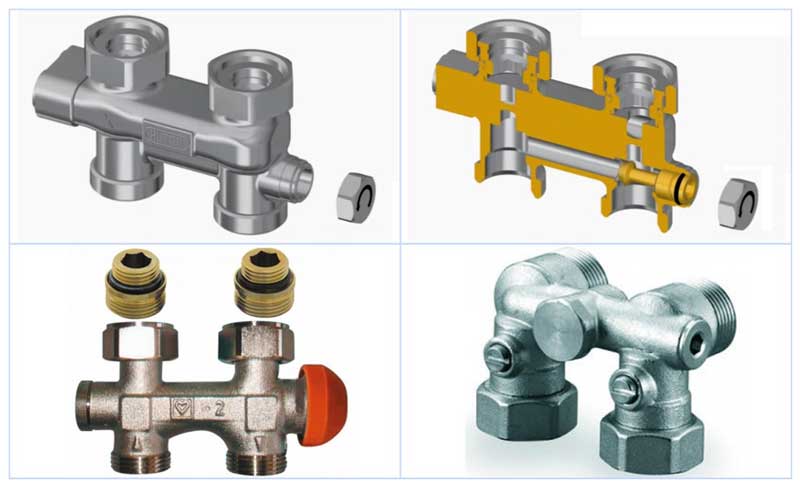

Fig. 5 Units with integrated bypass
In addition to the standard design with built-in shut-off or control valves, reminiscent of binoculars in appearance, there is a fairly wide range of products on the construction market that have a design that is different from the standard unit. The main modifications of the nodes presented in the trading network:
- With shut-off or control valves. The fitting is designed for connection to a two-pipe system, ball or screw valves with a recessed head for a flat screwdriver mounted in the body allow you to separately regulate the supply and return flows if balancing is necessary, as well as disconnect the radiator from the heating line.
- With built-in bypass. The Hummel radiator fittings have such a scheme - in its lower part there is a bypass channel, the passage diameter of which is regulated by a screw valve. This design is effective for single-pipe systems in which it is desirable to maintain the same coolant temperature at the inlet of all radiator heat exchangers. In addition, the set of the Hummel radiator fittings includes eccentric nuts, which are needed to connect it to pipe branches with different axial distances - this avoids poor-quality installation with deviations in alignment.
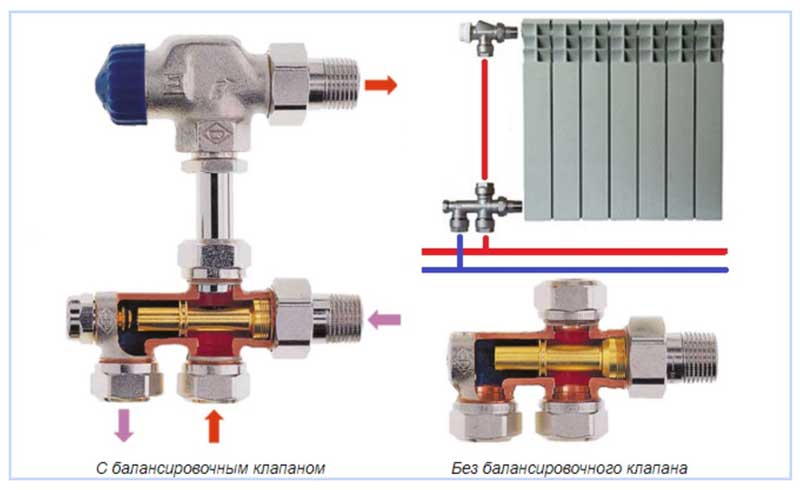

Fig. 6 Vertical bypass design
- With external bypass. The connection diagram of radiators with a bypass allows you to increase the temperature of the passing flow to increase the heating of the following batteries and, accordingly, equalize their heat transfer throughout the entire circuit. The bypass line is connected to the side of the radiator, the bypass tube is connected to its upper point through a fitting in which a thermostatic head is built. Since the coolant enters through the bypass to the upper part of the heater and then flows down, returning to the circuit through the return, its heating efficiency is much higher than that of modifications of a purely bottom connection with a heat loss of about 20%. Also, in the model with a vertical bypass, there is a screw for adjusting the return flow of the coolant, sometimes an automatic air vent is built in upward.
Fig. 7 Injector line - principle of operation and design
- Injection. The types of lower connection devices include injection devices that are connected to the side of the battery from the bottom, the circuit includes a tube inserted into the outlet housing branch pipe. The hot medium is poured into the radiator through an inlet around the tube, and through it returns to the return. There is a valve regulator in the side of the injector, in some models it is replaced by a thermostat, and the device also provides the ability to adjust the backflow rate with a screw.
In addition to the devices listed above, a number of other modifications of n-shaped fittings are produced, which have different design features of the fittings - devices with a cross direction of flows, elements with a branch in the side part for draining water (drainage), with transition eccentrics, offset coaxiality of inlet and outlet openings.
Fig. 8 Connection and variations of the model range of lower entry units
Node connection diagram
The main types of radiators for heating, which are connected with a low lead, are steel panel and bimetallic (withstand high pressure), much less often the terminals located at the bottom are found in the design of an aluminum radiator and tubular modifications.
Since the liquid supply from below can be used in a one-pipe and two-pipe system, its scheme is no different from other methods of connecting and connecting radiators (side diagonal, top). With a single-pipe wiring, the standard heating circuit needs a manual or automatic adjustment; the Tichelman wiring (passing) helps to significantly simplify balancing, in which the total length of the heating supply and return circuit is the same for all heaters.
Fig. 9 Diagram for connecting radiators from below
We connect heating radiators correctly
Regardless of the type of radiators chosen and the connection diagram suitable for them, it is important to calculate and mount everything correctly. In each specific case, its own system will be optimal.
For expensive houses of a large area, it is advisable to contact specialists who can offer the best project. This is not a question to economize on.
In each specific case, its own system will be optimal. For expensive houses of a large area, it is advisable to contact specialists who can offer the best project. This is not an issue to economize on.
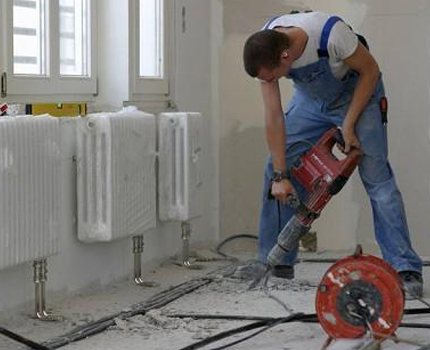

In order to correctly install and connect heating devices in a complex design scheme, it is better to use the services of professionals
For small residential houses, you can independently choose a suitable scheme and install heating devices. It is imperative to take into account the peculiarities of your home, the rules for installing batteries and the advisability of using a particular scheme.
When installing radiators, one must not forget that the type of material for the battery itself and the pipes must be the same. Plastic pipes connected to cast iron heaters will bring a lot of problems, ruining the heating system.
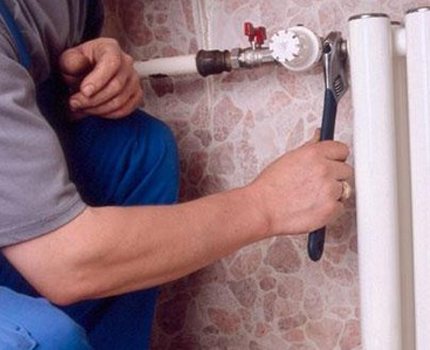

Being engaged in self-installation of heating batteries, one should not forget from the installation of ball valves for air bleeding and a regulator at the inlet

